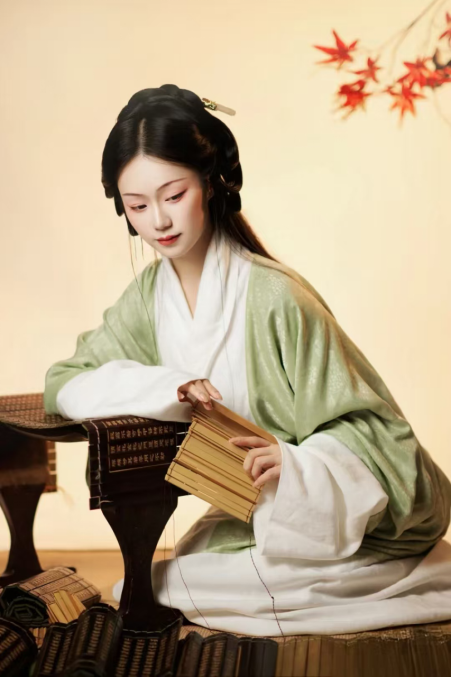Embroidery is a widely regional handicraft. Through long-term accumulation and development, each country and each ethnic group has its own strengths and advantages. In China, in addition to the “Four Famous Embroideries” – Su embroidery, Xiang embroidery, Yue embroidery and Shu embroidery, there are also local famous embroideries such as Beijing embroidery, Lu embroidery, Bian embroidery, Ou embroidery, Hang embroidery, Han embroidery and Min embroidery. China’s ethnic minorities, such as Uygur, Yi, Dai, Buyi, Kazak, Yao and Miao, also have their own characteristic ethnic embroideries.
Innovative Uses of Traditional Hanfu Embroidery in Modern Clothing Design
As classic culture regains popularity, young people increasingly embrace hanfu. Representing China’s ancient heritage, elegance, and historical worth, hanfu holds deep significance. Its intricate embroidery—featuring graceful lines and detailed patterns—captures widespread admiration. Today, designers creatively integrate these traditional motifs into contemporary fashion.
- Incorporate Hanfu Embroidery Motifs
Modern designers apply iconic hanfu embroidery styles freely. They adorn accessories like jewelry and handbags with these timeless designs. Fashion brands also transfer distinctive floral or dragon patterns onto modern women’s wear, adding unique artistic flair. - Add Eye-Catching Accents to Plain Outfits
Simple solid-color garments benefit greatly from embroidered details. Stitch vibrant hanfu patterns onto basic pieces—like a crisp white shirt—instantly transforming them into personalized, stylish statements. - Embellish Footwear with Cultural Touches
Beyond apparel, hanfu embroidery elevates shoe designs. Contemporary women’s shoes gain character through delicate stitches and symbolic colors, blending heritage with modern trends.

The status of embroidery
Embroidery, also known as “needle embroidery” and commonly called “embroidering flowers”, is one of China’s excellent traditional national crafts. After thousands of years of development, Chinese embroidery has formed a complete set of traditional clothing composition systems, including techniques, materials and cultural meanings, weaving the historical track of the Chinese nation in every stitch and thread.

The craftsmanship of embroidery
Embroidery is a craft that uses colored silk, velvet and cotton threads to pierce through the base cloth such as silk, satin, linen and kudzu to form patterns, images or characters. Chinese embroidery is famous in the world for its beautiful, elegant, moist artistic characteristics and rich and exquisite techniques, and has been popular for thousands of years.

Fabric
Chinese embroidery is beautiful in its appearance design and every thread and needle. Then, the important element that promotes the development and growth of embroidery – fabric, cannot be ignored and is worth exploring. Embroidery outlines with threads of different materials and colors on the basis of the base cloth, thus forming countless exquisite patterns. Therefore, it is the clusters of thread fabrics that weave the patterns that really play a role in embroidery.

Cotton and linen
The earliest and most widely used embroidery fabrics are cotton and linen. Cotton cloth is moisture-absorbent and breathable, with a relatively stable structure. When used as embroidery fabric, it needs to be processed in different refined ways. The cotton and linen are drawn and toughened to make them have the material strength required for embroidery. Then, according to different needs, the thread fabrics of cotton and linen are dyed to different degrees. After drying and forming, they can be used as embroidery raw materials. Typical embroidery fabrics made on the basis of cotton and linen include fine plain cloth and poplin.
Linen embroidery fabrics feel much rougher, and their refinement is slightly inferior to other materials. But fortunately, linen processing is simple. Although the threads made of it are coarser in material, the requirements for embroidery forming are not high, and various patterns are also endless.

Silk
In addition to the common embroidery fabrics like cotton and linen, silk has been synonymous with embroidery fabrics in a long period of Chinese history and is also a key link in making embroidery famous. Su embroidery and Shu embroidery are famous embroideries made of silk. Silk embroidery, with the flexibility, smoothness and absolute delicacy endowed by natural protein fibers, has always been the best choice for embroidery fabrics. Because of its high degree of refinement, it is more flexible and efficient to knit and outline patterns on the basis of silk. In pattern embroidery, silk can also make many patterns vivid. The traditional beauty expressed by embroidery patterns can touch the heart more directly, making many spiritual expressions vivid. Silk embroidery can present more different colors in dyeing, integrate different elements in embroidery, and rely on unique embroidery techniques to create the amazing embroidery works we see today.
Nowadays, embroidery has already entered ordinary people’s homes. Embroidery designs on clothes are everywhere. The integration of embroidery elements with modern life is constantly improving. Choosing embroidery as an artistic condiment in life can enrich one’s traditional aesthetic concepts and also feel the different cultural charms outlined by each stitch and thread. Finally, when choosing embroidery, you should choose the right material. You should know that different materials differ in appearance, flexibility and refinement. Choose the embroidery style that suits your taste. Since we choose it carefully, it is worth the aesthetic value that embroidery brings us.







